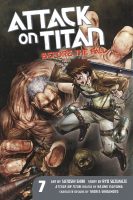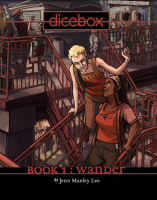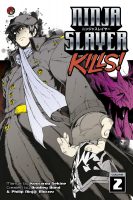My News and Reviews
I ended up posting it a little later than I really intended, but my random musings on TCAF 2016 are now available to read. Although I didn’t make it to as many panels this year, I still had a great time and really enjoyed myself. I haven’t had a chance to listen to the audio yet, but I was also happy to discover that some of the panels that I missed The Sparkling World of Shojo Manga. In licensing news, Yen Press has picked up both the light novels and the manga for Death March to the Parallel World Rhapsody and Konosuba. Princess Jellyfish has been doing well enough for Kodansha Comics that the publisher is considering releasing more josei and seinen. In the meantime, expect to see more additions to the Attack on Titan franchise in English from Kodansha as well as Shuzo Oshimi’s manga Happiness. Also, Vertical Comics will be releasing Chihiro Ishizuka’s manga series Flying Witch.
Quick Takes
 Attack on Titan: Before the Fall, Volume 7 written by Ryo Suzukaze and illustrated by Satoshi Shiki. I missed reading a few volumes of the Before the Fall manga, but I have read the original novel that it was based on so I didn’t expect that I would have much trouble picking the series up again. However, I think that the manga might actually be expanding on some of the material of the original, because I don’t recall things playing out exactly in the same way as they are in the manga. Or it could just be that it’s been so long since I’ve read the novel that I’ve managed to forget major plot points. Either way, I do like the way that Before the Fall expands the worldbuilding of Attack on Titan and how the prequel emphasizes some of the scientific and technological advances that are needed to make the main series work. Basically, the main character, in addition to having the requisite tragic backstory, is a test pilot (if that’s the right word) for what will eventually become the Vertical Maneuvering Equipment. A significant portion of the seventh volume of the Before the Fall manga is actually devoted to a field test which, like most encounters with the Titans, ist fraught with danger, disaster, and potential death.
Attack on Titan: Before the Fall, Volume 7 written by Ryo Suzukaze and illustrated by Satoshi Shiki. I missed reading a few volumes of the Before the Fall manga, but I have read the original novel that it was based on so I didn’t expect that I would have much trouble picking the series up again. However, I think that the manga might actually be expanding on some of the material of the original, because I don’t recall things playing out exactly in the same way as they are in the manga. Or it could just be that it’s been so long since I’ve read the novel that I’ve managed to forget major plot points. Either way, I do like the way that Before the Fall expands the worldbuilding of Attack on Titan and how the prequel emphasizes some of the scientific and technological advances that are needed to make the main series work. Basically, the main character, in addition to having the requisite tragic backstory, is a test pilot (if that’s the right word) for what will eventually become the Vertical Maneuvering Equipment. A significant portion of the seventh volume of the Before the Fall manga is actually devoted to a field test which, like most encounters with the Titans, ist fraught with danger, disaster, and potential death.
 Dicebox, Volume 1: Wander by Jenn Manley Lee. I discovered Lee’s ongoing comic Dicebox a couple of years ago while reading Comics: A Global History, 1968 to the Present where it was briefly mentioned. It piqued my interest so I thought I would give Wander, the first book out of four planned volumes (the second book is currently being serialized online), a try. I suspected that Dicebox would probably be a comic I would enjoy, but I didn’t expect that I would become so invested in the characters by the end of the first volume. Wander is almost completely driven by the characters and their relationships—the dramatic story boiling under the surface doesn’t become obvious until the final few chapters. Dicebox follows the lives of Molly and Griffin, two itinerant blue-collar workers moving from one job to the next, from one planet to the next. Molly tends to be fairly well liked, but Griffin, well she tends to piss people off, sometimes intentionally and sometimes not. Eventually it’s revealed that one of the reasons that Molly puts up with Griffin is that they are married. Dicebox is incredibly well-realized near-future science fiction. It’s also undeniably queer, and quite possibly has the widest representation of the variance of human gender and sexuality that I’ve ever come across in a single work of fiction, comic or otherwise. I’m loving Dicebox and definitely plan on reading more of the series.
Dicebox, Volume 1: Wander by Jenn Manley Lee. I discovered Lee’s ongoing comic Dicebox a couple of years ago while reading Comics: A Global History, 1968 to the Present where it was briefly mentioned. It piqued my interest so I thought I would give Wander, the first book out of four planned volumes (the second book is currently being serialized online), a try. I suspected that Dicebox would probably be a comic I would enjoy, but I didn’t expect that I would become so invested in the characters by the end of the first volume. Wander is almost completely driven by the characters and their relationships—the dramatic story boiling under the surface doesn’t become obvious until the final few chapters. Dicebox follows the lives of Molly and Griffin, two itinerant blue-collar workers moving from one job to the next, from one planet to the next. Molly tends to be fairly well liked, but Griffin, well she tends to piss people off, sometimes intentionally and sometimes not. Eventually it’s revealed that one of the reasons that Molly puts up with Griffin is that they are married. Dicebox is incredibly well-realized near-future science fiction. It’s also undeniably queer, and quite possibly has the widest representation of the variance of human gender and sexuality that I’ve ever come across in a single work of fiction, comic or otherwise. I’m loving Dicebox and definitely plan on reading more of the series.
 Ninja Slayer Kills!, Volume 2 by Koutarou Sekine. I can’t say that I was overly impressed by the first volume of Ninja Slayer Kills and I really wasn’t planning on following the series, but I ended up with a review copy of the second volume, so I figured I might as well give it a try. I am admittedly surprised, but I enjoyed the second volume much more than the first. Almost the entirety of the second volume is devoted to a flashback, which is easy to miss unless close attention is paid to the manga’s prefatory material. Some of my complaints about the manga remain the same—for a series that is so focused on fight scenes and mayhem, the action can be frustratingly difficult to follow—but other aspects have improved. For one, there is absolutely no mistaking at least one of the character designs. Agony visually looks something like a highly-sexualized version of Pinhead from Hellraiser, complete with an enormous crotch-bulge sprouting numerous needles. The design is more disturbing than sexy, but it is memorable. Ninja Slayer Kills is all about being as over-the-top as possible, often reading like an in-your-face parody. It’s deliberately absurd and ridiculously violent, intentionally making heavy use of cyberpunk ninja tropes taken to their extremes.
Ninja Slayer Kills!, Volume 2 by Koutarou Sekine. I can’t say that I was overly impressed by the first volume of Ninja Slayer Kills and I really wasn’t planning on following the series, but I ended up with a review copy of the second volume, so I figured I might as well give it a try. I am admittedly surprised, but I enjoyed the second volume much more than the first. Almost the entirety of the second volume is devoted to a flashback, which is easy to miss unless close attention is paid to the manga’s prefatory material. Some of my complaints about the manga remain the same—for a series that is so focused on fight scenes and mayhem, the action can be frustratingly difficult to follow—but other aspects have improved. For one, there is absolutely no mistaking at least one of the character designs. Agony visually looks something like a highly-sexualized version of Pinhead from Hellraiser, complete with an enormous crotch-bulge sprouting numerous needles. The design is more disturbing than sexy, but it is memorable. Ninja Slayer Kills is all about being as over-the-top as possible, often reading like an in-your-face parody. It’s deliberately absurd and ridiculously violent, intentionally making heavy use of cyberpunk ninja tropes taken to their extremes.

Speak Your Mind